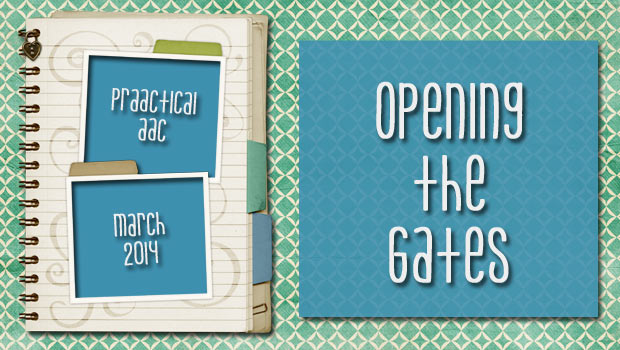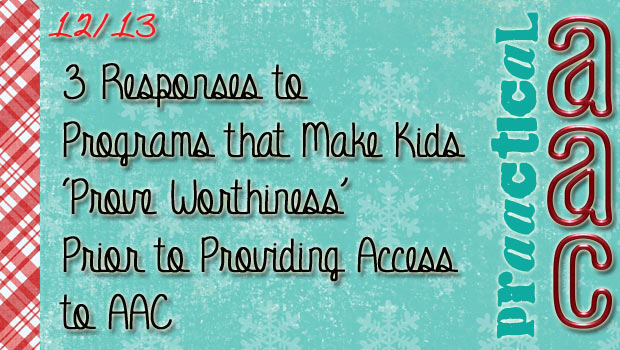Opening the Gates

For many users of AAC, the road to communicative competence is an arduous one. Consider the case of JJ, a bright 4 year old with severe motor limitations, who enters a typical preschool with only a few intelligible words.
After months of meetings, on the first day of school, his proud parents carry him into the classroom. They fasten him into an adapted chair that they brought for him to sit in and spend a half hour giving his aide instructions about his likes and dislikes, feeding difficulties, and toileting needs. Meanwhile, his teacher introduces him to some classmates, who are amazed, curious, and a little frightened of his unusual chair, constant drooling, grunting sounds, and random, jerky movements. One brave soul offers the child a toy, but JJ’s unruly arms bat it away and won’t let him take it. His would-be friend steps back, a bit confused. As they move to circle time, JJ makes seemingly random sounds and movements while his classmates tell their ages, name the day and the month, talk about the weather, choose classroom jobs, sing songs with fingerplays, and show and tell about a special toy. JJ’s eyes follow the teacher’s every movement, expectant and hopeful.
JJ has been in school exactly 35 minutes. He is already light-years behind.
The challenge is overwhelming. Within the shortest possible time, the educational team must find a way for JJ to:
- communicate his basic needs,
- participate in classroom routines,
- move around the classroom and school,
- pick up and hold toys and educational materials,
- use the computer,
- hold and look through books,
- begin to write and draw,
- retell stories,
- make friends,
- explain things,
- ask questions,
- fight and make up,
- interrupt,
- whine and complain,
- tease,
- complement,
- be in school plays,
- count and measure,
- solve problems,
- make an animal mask, and
- show what he’s learned.
In sum, he must play catch-up: learning more and faster than the other 4 year olds. What stands between JJ and success are the tools, services, and support we provide.
As SLPs, we’re often seen as the gatekeepers to AAC devices for these children. It’s a heavy responsibility, and SLPs need to be aware of the power they wield. These situations are complex and valid assessment data can be hard to come by. When we aren’t sure of the skill level or can’t fully predict what he’ll need or be able to do in a few months’ time, we should err on the side of caution by presuming that the child IS capable and WILL learn if provided with the right tools and enough good intervention.
It all starts with believing in the child. Yes, the road is long and convoluted, with many bumps and a few big gates. Let’s be the profession known for opening them.
Filed under: PrAACtical Thinking
Tagged With: prerequisites
This post was written by Carole Zangari


9 Comments
Amazingly written. Thank you.
Thanks for this inspirational blog. It is true. We have the knowledge and resources (at leadt we should be able to access them) to help our children and adults find s way to communicate even though their physical status may limit them. Loved it
Thanks for your kind comments, Betsy and Lena! It can be overwhelming to think about how to address the needs of kids like JJ, especially when caseloads are too large and resources are too few. There are a lot of amazing AAC SLPs out there who are doing phenomenal work and changing the educational trajectories of kids like JJ. We just need to figure out a way to ‘reach’ those of our SLP colleagues who are not yet supporting the AAC needs of their students. It is a challenge, to say the least. Thank you for taking the time to comment. Much appreciated!
My son was much like JJ, only it was 18 years ago that he was a 4 year old preschooler. We were very lucky to have a fabulous non-public special education preschool and kindergarten that was instrumental in starting us on the right path, and I still credit them with much of his success. Today he is a 21 year old college student, going away to a school 600 miles from our home. It would be impossible for him to function in that environment without his excellent skills with his AAC device.
That is music to our ears, Danya! We are eager for the day when these stories are the norm. 🙂
AAC is a vital component of a nonverbal child’s education yet after going through all the hoops to get the student the needed equipment I still come into classrooms where the ipad or device is in a closet or on a shelf until they see the SLP. I have tried model lessons, talking about how it takes time for a verbal student to use expressive language yet we don’t say “Um he can’t use this voice box, lets lock it in a closet”, using the “Its on his IEP” card, everything. I have been at this for over 20 years yet still it happens.
Janis, we’ve had same experience more times that we’d like to remember. Very disheartening! However, to be fair to our colleagues who are teachers, there are many problems within our own profession, too. We continue to experience and learn of situations where the teacher is providing AAC instruction, and the SLP wants nothing to do with it. There are fabulous professionals out there, but not enough of them. We need pervasive, high-quality AAC intervention to be the general case scenario and not the exception. Thanks for stopping by and taking the time to show your solidarity, Janis!
Spot on motivating post – forwarded to many SLP’s I consult with to cheer them on. Thanks for all you are doing. So wonderful to have these great resources in one location.
Thanks for taking the time to comment, Keri, and, for sharing the link. I can’t tell you how much we appreciate that support! We are feeling hopeful that a groundswell of SLPs who believe in these kids and know AAC will outnumber those whose who are reluctant to open the gates.